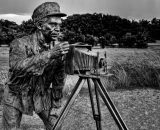- Forum
- Photography and Camera Forum
- Camera Manufacturers - by Brand
- Canon Camera Forum
- Sigma 18-35mm f/1.8 DC HSM lens Announced!
Sigma 18-35mm f/1.8 DC HSM lens Announced!
Post #280922
Sigma Corporation announces world’s first F1.8 constant aperture zoom lens
RONKONKOMA, NY, Apr. 18, 2013 — Sigma Corporation of America ( www.sigmaphoto.com ), a leading researcher, developer, manufacturer and service provider for some of the world’s most impressive lines of lenses, cameras and flashes, today announced the Sigma 18-35mm F1.8 DC HSM Art lens, the market’s first zoom lens to achieve a maximum aperture F1.8 throughout the entire zoom range.
This revolutionary, wide aperture, standard zoom lens is created for DSLR cameras with APS-C size sensors, which translates to a focal range of 27-52.5mm on a 35mm camera. With a minimum focusing distance of 11 inches, and a maximum magnification ratio of 1:4.3, the 18-35mm is ideal for landscapes, portraits, still-life, studio, close-up and casual photography.
“Exceptionally fast apertures were previously unavailable in zoom lenses, so photographers turned to several prime lenses in a session to get bright images at various focal lengths. We’re incredibly excited to be the first manufacturer to bring the F1.8 standard zoom to the market and to provide photographers with a new level of creativity and convenience, with the outstanding image quality at the core of the new Sigma Global Vision,” said Mark Amir-Hamzeh, president of Sigma Corporation of America.
Amir-Hamzeh added that because developing a large aperture wide angle zoom lens can prove to be technologically and optically challenging, often resulting in various distortions, aberrations and field curvature, Sigma has tapped into its long history as a lens pioneer to overcome those issues in this new generation lens.
“Our experience with the wide angle designs of our 12-24mm F4.5-5.6 II DG HSM and our 8-16mm F4.5-5.6 DC HSM, and our research and development in our Aizu factory have prepared us for this technological advancement,” he said. “Our wide, glass-molded aspherical lens and the incorporation of Special Low Dispersion (SLD) glass have optimized power distribution of the optical elements and compensated for various aberrations, as well as curvature of field at the widest angle. We’re extremely proud of this achievement.”
The 18-35mm is the latest addition to the company’s company’s Art line of lenses, designed under the new Global Vision. The Global Vision lenses have a sleek new design with the manufacturing year stamped on the barrel, and are categorized by use into one of three groups: Art, Contemporary and Sports. The Art category delivers high-level artistic expression through sophisticated and abundant expressive power.
The new 18-35mm lens incorporates Sigma’s improved AF/MF switch and the use of Thermally Stable Composite (TSC) compound material, which has a high affinity to metal parts, consistently performs well at extreme temperatures, and reduces the size and weight of the lens. It is also compatible with Sigma’s new USB Dock, which will be available in coming months, enabling photographers to update lens firmware and adjust focus parameters from their computers.
Convenient handling is achieved with internal focusing and zooming, which prevents changes to the size of the lens. Additionally, the front part of the lens does not rotate, so special filters like circular polarizers can be used.
The 18-35mm lens’ Super Multi-Layer Coating reduces flare and ghosting and provides sharp and high contrast images, even in backlit conditions. The petal-type hood that is supplied with the lens will provide extra protection from flare and ghosting. Sigma’s Hyper Sonic Motor (HSM) ensures a silent, high-speed AF function and the optimized auto focus algorithm results in smooth focusing and full-time manual focusing capability. Lastly, the nine-blade, rounded diaphragm creates an attractive, round bokeh at large-aperture settings.
Sigma 18-35mm f:1.8 DC HSM
Specs
Designed for APS-C based DSLR cameras
Ultrasonic autofocus (HSM)
9 aperture blades
Type A (Art), which guarantees quality materials, metal bayonet
Filter size: 72mm
Minimum aperture: f/16
Lens construction: 17 elements in 12 groups
The maximum magnification ratio: 0.23x
Weight: 810 grams, length: 121mm
Angle of view: 76.5 – 44.2°
Internal zoom and focusing
Minimal focusing distance: 28cm
canontweets.com/2013/04/sigma-18-35mm-f1-8-dc-hsm-lens/
Canon 7D, 15-85mm, 18-55mm, 70-200mm, 100mm Macro, Sigma 120-300mm, Speedlite 430EX II
A bad day at the race track is better than a good day in the office
-

- garyrhook
- Oh Wise One
-
- Nikon D850, Nikon D750, Panasonic G7K
- Followers: 912
- Posts: 11103
-
Points:
67681
Post #280941
CanonKid wrote: This revolutionary, wide aperture, standard zoom lens is created for DSLR cameras with APS-C size sensors, which translates to a focal range of 27-52.5mm on a 35mm camera.
Aaagggghhhh! It does not, it does not, it does not! They should know better.
-

- Scotty
- Agent 007
- James Bond, PT mod.
- Followers: 1088
- Posts: 9888
-
Points:
15096
Post #280960
garyrhook wrote:
CanonKid wrote: This revolutionary, wide aperture, standard zoom lens is created for DSLR cameras with APS-C size sensors, which translates to a focal range of 27-52.5mm on a 35mm camera.
Aaagggghhhh! It does not, it does not, it does not! They should know better.
It does. 1.5 crop factor.
When the last candle has been blown out
and the last glass of champagne has been drunk
All that you are left with are the memories and the images-David Cooke.
-

- garyrhook
- Oh Wise One
-
- Nikon D850, Nikon D750, Panasonic G7K
- Followers: 912
- Posts: 11103
-
Points:
67681
Post #280966
Scotty wrote:
garyrhook wrote:
CanonKid wrote: This revolutionary, wide aperture, standard zoom lens is created for DSLR cameras with APS-C size sensors, which translates to a focal range of 27-52.5mm on a 35mm camera.
Aaagggghhhh! It does not, it does not, it does not! They should know better.
It does. 1.5 crop factor.
It (the sensor size) affects the view field. It does not affect the focal length or range. That makes their statement inaccurate.
-

- Scotty
- Agent 007
- James Bond, PT mod.
- Followers: 1088
- Posts: 9888
-
Points:
15096
Post #280967
garyrhook wrote:
Scotty wrote:
garyrhook wrote:
CanonKid wrote: This revolutionary, wide aperture, standard zoom lens is created for DSLR cameras with APS-C size sensors, which translates to a focal range of 27-52.5mm on a 35mm camera.
Aaagggghhhh! It does not, it does not, it does not! They should know better.
It does. 1.5 crop factor.
It (the sensor size) affects the view field. It does not affect the focal length or range. That makes their statement inaccurate.
Focal length is the distance between the rear element and the sensor. Focal range is the reach of the lens.
When the last candle has been blown out
and the last glass of champagne has been drunk
All that you are left with are the memories and the images-David Cooke.
-

- McBeth Photography
- Photo Guru
-
- Sinar Norma 4x5
- Followers: 365
- Posts: 3870
-
Points:
1295
Post #280968
It is what it is.
-

- KCook
- Photo Elder
-
- Canon EOS 50D and Olympus E-P5
- Followers: 1325
- Posts: 5410
-
Points:
32913
-

- Scotty
- Agent 007
- James Bond, PT mod.
- Followers: 1088
- Posts: 9888
-
Points:
15096
Post #280980
KCook wrote:
- Weight: 810 grams, length: 121mm
This thing is a beast. I will pass.
rofl that's lighter than the 24-70.
When the last candle has been blown out
and the last glass of champagne has been drunk
All that you are left with are the memories and the images-David Cooke.
-

- KCook
- Photo Elder
-
- Canon EOS 50D and Olympus E-P5
- Followers: 1325
- Posts: 5410
-
Points:
32913
-

- Scotty
- Agent 007
- James Bond, PT mod.
- Followers: 1088
- Posts: 9888
-
Points:
15096
Post #280990
KCook wrote:
... which is a full frame design ...Scotty wrote:
KCook wrote:
- Weight: 810 grams, length: 121mm
This thing is a beast. I will pass.
rofl that's lighter than the 24-70.
You need to work out.
When the last candle has been blown out
and the last glass of champagne has been drunk
All that you are left with are the memories and the images-David Cooke.
-

- garyrhook
- Oh Wise One
-
- Nikon D850, Nikon D750, Panasonic G7K
- Followers: 912
- Posts: 11103
-
Points:
67681
Post #281006
Scotty wrote: Focal length is the distance between the rear element and the sensor. Focal range is the reach of the lens.
I understand that. The sensor size does not affect the geometry of either of those in any way. The view size is what it is, but it does not change the behavior of the lens.
It's pretty much decided that the manufacturer's should never have tried to liken APS-C sensor sizes to full-frame sizes in this way. The fact of the matter is that it is impossible, geometrically speaking, to completely and precisely recreate an image in camera from one sensor type to another, crop factor included. The geometry does not allow it. I don't get why some insist on making this comparison.
-

- Scotty
- Agent 007
- James Bond, PT mod.
- Followers: 1088
- Posts: 9888
-
Points:
15096
Post #281007
garyrhook wrote:
Scotty wrote: Focal length is the distance between the rear element and the sensor. Focal range is the reach of the lens.
I understand that. The sensor size does not affect the geometry of either of those in any way. The view size is what it is, but it does not change the behavior of the lens.
It's pretty much decided that the manufacturer's should never have tried to liken APS-C sensor sizes to full-frame sizes in this way. The fact of the matter is that it is impossible, geometrically speaking, to completely and precisely recreate an image in camera from one sensor type to another, crop factor included. The geometry does not allow it. I don't get why some insist on making this comparison.
What they are stating is true. I'm not sure what you're arguing.
When the last candle has been blown out
and the last glass of champagne has been drunk
All that you are left with are the memories and the images-David Cooke.
-

- garyrhook
- Oh Wise One
-
- Nikon D850, Nikon D750, Panasonic G7K
- Followers: 912
- Posts: 11103
-
Points:
67681
Post #281009
We don't have to tolerate this nonsense when discussing full-frame vs. medium format, do we? Or am I just missing something.
-

- Scotty
- Agent 007
- James Bond, PT mod.
- Followers: 1088
- Posts: 9888
-
Points:
15096
Post #281010
garyrhook wrote: Well, try as I might, I can't find a single definition of "focal range" (via google) that matches your assertion as to its meaning. It appears to be synonymous with "focal length". If so, at the risk of repeating myself, the crop factor has zero to do with the focal length/range/whatever. Nothing, period. The view area is what it is, and the two are unrelated. It's asinine for manufacturers to obfuscate this issue, because a crop sensor camera is not going to cause a (e.g.) 35mm lens to change the way it processes light rays one iota. It does what it does.It's just a lens and it behaves according to physics. You want to capture a larger area of the image it produces, get a larger sensor.
We don't have to tolerate this nonsense when discussing full-frame vs. medium format, do we? Or am I just missing something.
They do focal range or reach when talking about comparisons for hasseblads, and phase one IQ 180's. I've heard it in the movie industry in the studio.
I think we're talking about the same thing.
When the last candle has been blown out
and the last glass of champagne has been drunk
All that you are left with are the memories and the images-David Cooke.
-

- KCook
- Photo Elder
-
- Canon EOS 50D and Olympus E-P5
- Followers: 1325
- Posts: 5410
-
Points:
32913
- Forum
- Photography and Camera Forum
- Camera Manufacturers - by Brand
- Canon Camera Forum
- Sigma 18-35mm f/1.8 DC HSM lens Announced!
Latest Reviews
The Olympus Pen E-P7 is an affordable micro four thirds mirrorless camera with 4K video capabilities, a 20.3MP sensor, and 121 focus points, making it a solid entry-level camera for beginners.
The Panasonic G9 II is a 25.2-megapixel micro four thirds camera with numerous features that make it punch out of its weight class, like 779 AF points, 5.8K video, and weather sealing.
The Fujifilm XT5 is a 40MP mirrorless camera capable of 6.2K video at 30p. With those specs, it’s an ideal choice for photographers needing a camera to pull double duty for imaging and video.
The Canon EOS R100 is an entry-level mirrorless camera introduced in 2023. But just because it’s an entry-level camera doesn’t mean it’s a bare-bones camera. Find out why in this review!
Latest Articles
Upgrade your kit in 2024 with the best intermediate camera on the market! The question is, what camera fits the bill? We’ve got three top options for you to choose from in this buyer’s guide.
The best photography jobs right now are a mix of tried-and-true gigs like wedding photography and new jobs highlighting AI’s capabilities, travel, and videography.
The Olympus Pen E-P7 is an affordable micro four thirds mirrorless camera with 4K video capabilities, a 20.3MP sensor, and 121 focus points, making it a solid entry-level camera for beginners.
Starting a photography business is one thing; sustaining your business over a long period of time is another. Use the tips in this professional photography guide to build something with longevity!
The Panasonic G9 II is a 25.2-megapixel micro four thirds camera with numerous features that make it punch out of its weight class, like 779 AF points, 5.8K video, and weather sealing.
Cinematic photography is an interesting genre that combines photographic and videographic skills along with effective storytelling techniques. The result? Highly impactful images!
Newborn photography requires skill, the right gear, and a lot of patience. This beginner’s guide discusses critical topics that will help you be more prepared for before, during, and after the shoot.
To fill the frame means to expand the footprint of the subject in your shot. Get in close, zoom in, crop the image, or use other techniques to bring the subject to the forefront.















